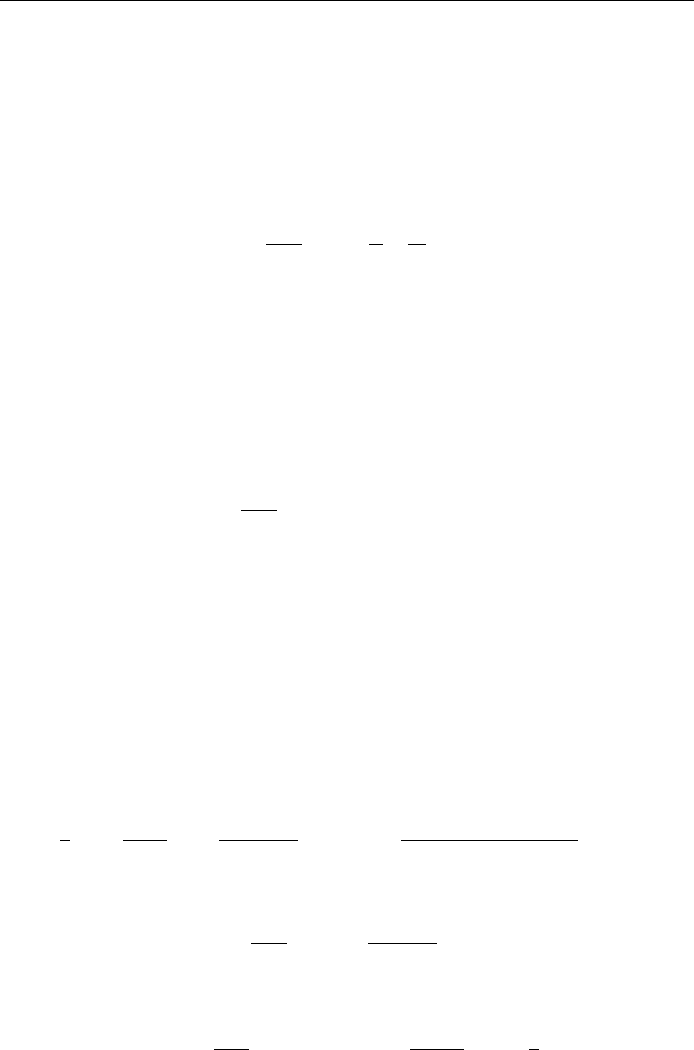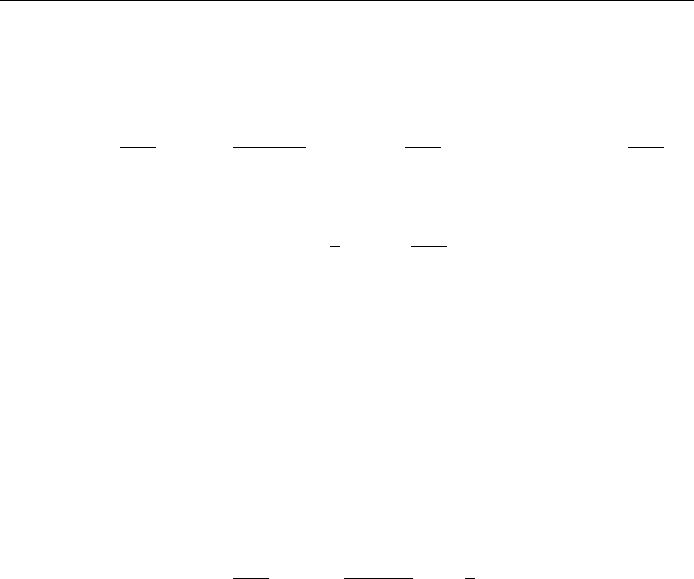Chow T.L. Mathematical Methods for Physicists: A Concise Introduction
Подождите немного. Документ загружается.


Example A1.8
P
1
n1
1=n
2
converges since lim
M!1
R
M
1
dx=x
2
lim
M!1
1 ÿ 1=M exists.
Problem A1.10
Find the limit of the sequence 0.3, 0.33, 0:333; ...; and justify your conclusion.
Alternating series test
An alternating series is one whose successive terms are alternately positive and
negative u
1
ÿ u
2
u
3
ÿ u
4
: It converges if the following two conditions are
satis®ed:
(a) ju
n1
ju
n
j for n 1; (b) lim
n!1
u
n
0
or lim
n!1
u
n
jj
0
:
The sum of the series to 2M is
S
2M
u
1
ÿ u
2
u
3
ÿ u
4
u
2Mÿ1
ÿ u
2M
u
1
ÿu
2
ÿ u
3
ÿu
4
ÿ u
5
ÿÿu
2Mÿ2
ÿ u
2Mÿ1
ÿu
2M
:
Since the quantities in parentheses are non-negative, we have
S
2M
0; S
2
S
4
S
6
S
2M
u
1
:
Therefore fS
2M
g is a bounded monotonic increasing sequence and thus has the
limit S.
Also S
2M1
S
2M
u
2M1
. Since lim
M!1
S
2M
S and lim
M!1
u
2M1
0
(for, by hypothesis, lim
n!1
u
n
0), it follows that lim
M!1
S
2M1
lim
M!1
S
2M
lim
M!1
u
2M1
S 0 S. Thus the partial sums of the series
approach the limit S and the series converges.
516
APPENDIX 1 PRELIMINARIES
Figure A1.3.

Problem A1.11
Show that the error made in stopping after 2M terms is less than or equal to
u
2M1
.
Example A1.9
For the series
1 ÿ
1
2
1
3
ÿ
1
4
X
1
n1
ÿ1
nÿ1
n
;
we have u
n
ÿ1
n1
=n; u
n
jj
1=n; u
n1
jj
1=n 1. Then for n 1;
u
n1
jj
u
n
jj
. Also we have lim
n!1
u
n
jj
0. Hence the series converges.
Absolute and conditional convergence
The series
P
u
n
is called absolutely convergent if
P
u
n
jj
converges. If
P
u
n
con-
verges but
P
u
n
jj
diverges, then
P
u
n
is said to be conditionally convergent.
It is easy to show that if
P
u
n
jj
converges, then
P
u
n
converges (in words , an
absolutely convergent series is convergent). To this purpose, let
S
M
u
1
u
2
u
M
T
M
u
1
jj
u
2
jj
u
M
jj
;
then
S
M
T
M
u
1
u
1
jj
u
2
u
2
jj
u
M
u
M
jj
2 u
1
jj
2 u
2
jj
2 u
M
jj
:
Since
P
u
n
jj
converges and since u
n
u
n
jj
0, for n 1; 2; 3; ...; it follows that
S
M
T
M
is a bounded monotonic increasing sequence, and so
lim
M!1
S
M
T
M
exists. Also lim
M!1
T
M
exists (since the series is absolutely
convergent by hypothesis),
lim
M!1
S
M
lim
M!1
S
M
T
M
ÿ T
M
lim
M!1
S
M
T
M
ÿ lim
M!1
T
M
must also exist and so the series
P
u
n
converges.
The terms of an absolutely convergent series can be rearranged in any order,
and all such rearranged series will converge to the same sum. We refer the reader
to text-book s on advan ced calculus for proof.
Problem A1.12
Prove that the series
1 ÿ
1
2
2
1
3
2
ÿ
1
4
2
1
5
2
ÿ
converges.
517
INFINITE SERIES

How do we test for absolute convergence? The simplest test is the ratio test,
which we now review, along with three others ± Raabe's test, the nth root test, and
Gauss' test.
Ratio test
Let lim
n!1
ju
n1
=u
n
jL. Then the series
P
u
n
:
(a) converges (absolutely) if L < 1;
(b) diverges if L > 1;
(c) the test fails if L 1.
Let us consider ®rst the positive-term
P
u
n
, that is, each term is positive. We
must now prove that if lim
n!1
u
n1
=u
n
L < 1, then necessarily
P
u
n
converges.
By hypothesis, we can choose an integer N so large that for all
n N; u
n1
=u
n
< r, where L < r < 1. Then
u
N1
< ru
N
; u
N2
< ru
N1
< r
2
u
N
; u
N3
< ru
N2
< r
3
u
N
; etc:
By addition
u
N1
u
N2
< u
N
r r
2
r
3
and so the given series converges by the comparison test, since 0 < r < 1.
When the series has terms with mixed signs, we consider u
1
jj
u
2
jj
u
3
jj
,
then by the above proof and because an absolutely convergent series is
convergent, it follows that if lim
n!1
u
n1
=u
n
jj
L < 1, then
P
u
n
converges
absolutely.
Similarly we can prove that if lim
n!1
u
n1
=u
n
jj
L > 1, the series
P
u
n
diverges.
Example A1.10
Consider the series
P
1
n1
ÿ1
nÿ1
2
n
=n
2
. Here u
n
ÿ1
nÿ1
2
n
=n
2
. Then
lim
n!1
u
n1
=u
n
jj
lim
n!1
2n
2
=n 1
2
2. Since L 2 > 1, the series diverges.
When the ratio test fails, the following three tests are often very helpful .
Raabe's test
Let lim
n!1
n1 ÿ u
n1
=u
n
jj
`, then the series
P
u
n
:
(a) converges absolutely if `<1;
(b) diverges if `>1.
The test fails if ` 1.
The nth root test
Let lim
n!1
u
n
jj
n
p
R, then the series
P
u
n
:
518
APPENDIX 1 PRELIMINARIES

(a) converges absolutely if R < 1;
(b) diverges if R > 1.
The test fails if R 1.
Gauss' test
If
u
n1
u
n
þ
þ
þ
þ
þ
þ
þ
þ
1 ÿ
G
n
c
n
n
2
;
where jc
n
j < P for all n > N, then the series
P
u
n
:
(a) converges (absolutely) if G > 1;
(b) diverges or converges conditionally if G 1.
Example A1.11
Consider the series 1 2r r
2
2r
3
r
4
2r
5
. The ratio test gives
u
n1
u
n
þ
þ
þ
þ
þ
þ
þ
þ
2 r
jj
; n odd
r
jj
=2; n even
;
which indicates that the ratio test is not applicable. We now try the nth root test:
u
n
jj
n
p
2 r
n
jj
n
p
2
n
p
r
jj
; n odd
r
n
jj
n
p
r
jj
; n even
(
and so lim
n!1
u
n
jj
n
p
r
jj
. Thus if jrj < 1 the series converges, and if jrj > 1 the
series diverges.
Example A1.12
Consider the series
1
3
2
1 4
3 6
2
1 4 7
3 6 9
2
1 4 7 3n ÿ 2
3 6 9 3n
:
The ratio test is not applicable, since
lim
n!1
u
n1
u
n
þ
þ
þ
þ
þ
þ
þ
þ
lim
n!1
3n 1
3n 3
þ
þ
þ
þ
þ
þ
þ
þ
2
1:
But Raabe' s test gives
lim
n!1
n 1 ÿ
u
n1
u
n
þ
þ
þ
þ
þ
þ
þ
þ
lim
n!1
n 1 ÿ
3n 1
3n 3
2
()
4
3
> 1;
and so the series converges.
519
INFINITE SERIES

Problem A1.13
Test for convergence the series
1
2
2
1 3
2 4
2
1 3 5
2 4 6
2
1 3 5 2n ÿ 1
1 3 5 2n
:
Hint: Neither the ratio test nor Raabe's test is applicable (show this). Try Gauss'
test.
Series of functions and uniform convergence
The series consider ed so far had the feature that u
n
depended just on n. Thus the
series, if convergent, is represented by just a number. We now consider series
whose terms are functions of x; u
n
u
n
x. There are many such series of func-
tions. The reader should be familiar with the power series in which the nth term is
a constant times x
n
:
Sx
X
1
n0
a
n
x
n
: A1:4
We can think of all previous cases as power series restricted to x 1. In later
sections we shall see Fourier series whose terms involve sines and cosines, and
other series in which the terms may be polynomials or other functions. In this
section we consider power series in x.
The convergence or divergence of a series of functions depends, in general, on
the values of x. With x in place, the partial sum Eq. (A1.2) now becomes a
function of the variable x:
s
n
xu
1
u
2
xu
n
x: A1:5
as does the series sum. If we de®ne Sx as the limit of the partial sum
Sxlim
n!1
s
n
x
X
1
n0
u
n
x; A1:6
then the series is said to be convergent in the interval [a, b] (that is, a x b), if
for each ">0 and each x in [a, b] we can ®nd N > 0 such that
Sxÿs
n
x
jj
<"; for all n N: A1:7
If N depends only on " and not on x, the series is called uniformly convergent in
the interval [a, b]. This says that for our series to be uniformly convergent, it must
be possible to ®nd a ®nite N so that the remainder of the series after N terms,
P
1
iN1
u
i
x, will be less than an arbitrarily small " for all x in the given interval.
The domain of convergence (absolute or uniform) of a series is the set of values
of x for which the series of functions converges (absolutely or uniformly).
520
APPENDIX 1 PRELIMINARIES

We deal with power series in x exactly as before. For example, we can use the
ratio test, which now depends on x, to investigate convergence or divergence of a
series:
rxlim
n!1
u
n1
u
n
þ
þ
þ
þ
þ
þ
þ
þ
lim
n!1
þ
þ
þ
þ
a
n1
x
n1
a
n
x
n
þ
þ
þ
þ
x
jj
lim
n!1
a
n1
a
n
þ
þ
þ
þ
þ
þ
þ
þ
x
jj
r; r lim
n!1
a
n1
a
n
þ
þ
þ
þ
þ
þ
þ
þ
;
thus the series converges (absolutely) if jxjr < 1or
jxj < R
1
r
lim
n!1
a
n
a
n1
þ
þ
þ
þ
þ
þ
þ
þ
and the domain of convergence is given by R : ÿR < x < R. Of course, we ne ed to
modify the above discussion somewhat if the power series does not contain every
power of x.
Example A1.13
For what value of x does the series
P
1
n1
x
nÿ1
=n 3
n
converge?
Solution: Now u
n
x
nÿ1
=n 3
n
,andx 6 0 (if x 0 the seri es converges). We
have
lim
n!1
u
n1
u
n
þ
þ
þ
þ
þ
þ
þ
þ
lim
n!1
n
3n 1
x
jj
1
3
x
jj
:
Then the series converges if jxj < 3, and diverges if jxj > 3. If jxj3, that is,
x 3, the test fails.
If x 3, the series becomes
P
1
n1
1=3n which diverges. If x ÿ3, the series
becomes
P
1
n1
ÿ1
nÿ1
=3n which converges. Then the interval of convergence is
ÿ3 x < 3. The series diverges outsi de this interval. Furthermore, the series
converges absolutely for ÿ3 < x < 3 and converges conditionally at x ÿ3.
As for uniform convergence, the most commonly encountered test is the
Weierstrass M test:
Weierstrass M test
If a sequence of positive constants M
1
; M
2
; M
3
; ...; can be found such that: (a)
M
n
ju
n
xj for all x in some interval [a, b], and (b)
P
M
n
converges, then
P
u
n
x is uniformly an d absolutely convergent in [a, b].
The proof of this common test is direct and simple. Since
P
M
n
converges,
some number N exists such that for n N,
X
1
iN1
M
i
<":
521
SERIES OF FUNCTIONS AND UNIFORM CONVERGENCE

This follows from the de®nition of convergence. Then, with M
n
ju
n
xj for all x
in [a, b],
X
1
iN1
u
i
x
jj
<":
Hence
Sxÿs
n
x
jj
þ
þ
þ
þ
X
1
iN1
u
i
x
þ
þ
þ
þ
<"; for all n N
and by de®nition
P
u
n
x is uniformly convergent in [a, b]. Furthermore, since we
have speci®ed absolute values in the statement of the Weierstrass M test, the series
P
u
n
x is also seen to be ab solutely convergent.
It should be noted that the Weierstrass M test only provides a sucient con-
dition for uniform convergence. A series may be uniformly convergent even when
the M test is not applicable. The Weierstrass M test might mislead the reader to
believe that a uniformly convergent series must be also absolutely con vergent, and
conversely. In fact, the uniform convergence and absolute convergence are inde-
pendent properties. Neither implies the other.
A somewhat more delicate test for uniform convergence that is especially useful
in analyzing power series is Abel's test. We now state it without proof.
Abel's test
If a u
n
xa
n
f
n
x, and
P
a
n
A, convergent, and (b) the functions f
n
x are
monotonic f
n1
xf
n
x and bounded, 0 f
n
xM for all x in [a, b], then
P
u
n
x converges uniformly in [a, b].
Example A1.14
Use the Weierstrass M test to investigate the uniform convergence of
a
X
1
n1
cos nx
n
4
; b
X
1
n1
x
n
n
3=2
; c
X
1
n1
sin nx
n
:
Solution:
(a) cosnx=n
4
þ
þ
þ
þ
1=n
4
M
n
. Then since
P
M
n
converges (p series with
p 4 > 1), the series is uniformly and absolutely convergent for all x by
the M test.
(b) By the ratio test, the series converges in the interval ÿ1 x 1 (or jxj1).
For all x in jxj1; x
n
=n
3=2
þ
þ
þ
þ
þ
þ
x
jj
n
=n
3=2
1=n
3=2
. Choosing M
n
1=n
3=2
,
we see that
P
M
n
converges. So the given series converges uniformly for
jxj1 by the M test.
522
APPENDIX 1 PRELIMINARIES

(c) sinnx=n=njj1=n M
n
. However,
P
M
n
does not converge. The M test
cannot be used in this case and we cannot conclude anything about the
uniform co nvergence by this test.
A uniformly convergent in®nite series of functions has many of the properties
possessed by the sum of ®nite series of functions. The following three are parti-
cularly useful. We state them without proofs.
(1) If the individual terms u
n
x are continuous in [a, b] and if
P
u
n
x c on-
verges uniformly to the sum Sx in [a, b], then Sx is continuous in [a, b].
Brie¯y, this states that a uniformly convergent series of continuous func-
tions is a continuous function.
(2) If the individual terms u
n
x are continuous in [a, b] and if
P
u
n
x c on-
verges uniformly to the sum Sx in [a, b], then
Z
b
a
Sxdx
X
1
n1
Z
b
a
u
n
xdx
or
Z
b
a
X
1
n1
u
n
xdx
X
1
n1
Z
b
a
u
n
xdx:
Brie¯y, a uniform convergent series of continuous functions can be inte-
grated term by term.
(3) If the individual terms u
n
x are continuous and have continuous derivatives
in [a, b] and if
P
u
n
x converges unifor mly to the sum Sx while
P
du
n
x=dx is uniformly convergent in [a, b], then the derivative of the
series sum Sx equals the sum of the individual term derivatives,
d
dx
Sx
X
1
n1
d
dx
u
n
x or
d
dx
X
1
n1
u
n
x
()
X
1
n1
d
dx
u
n
x:
Term-by-term integration of a uniformly convergent series requires only con-
tinuity of the individual terms. This con dition is almost always met in physical
applications. Term-by-term integration may also be valid in the absence of uni-
form convergence. On the other hand term -by-term diÿerentiation of a series is
often not valid because more restrictive conditions must be satis®ed.
Problem A1.14
Show that the series
sin x
1
3
sin 2x
2
3
sin nx
n
3
is uniformly convergent for ÿ x .
523
SERIES OF FUNCTIONS AND UNIFORM CONVERGENCE

Theorems on power series
When we are worki ng with power series and the functions they represent, it is very
useful to know the following theorems which we will state without proof. We will
see that, within their interval of convergence, power series can be handled much
like polyno mials.
(1) A power series converges uniformly and absolutely in any interval which lies
entirely within its interval of convergence.
(2) A power series can be diÿerentiated or integrated term by term over any
interval lying entirely within the interval of convergence. Also, the sum of a
convergent power series is continuous in any interval lying entirely within its
interval of convergence.
(3) Two power series can be added or subtracted term by term for each value of
x common to their intervals of convergence.
(4) Two power series, for example,
P
1
n0
a
n
x
n
and
P
1
n0
b
n
x
n
, can be multiplied
to obtain
P
1
n0
c
n
x
n
; where c
n
a
0
b
n
a
1
b
nÿ1
a
2
b
nÿ2
a
n
b
0
, the
result being, valid for each x within the common interval of convergence.
(5) If the power series
P
1
n0
a
n
x
n
is divided by the power series
P
1
n0
b
n
x
n
,
where b
0
6 0, the quotient can be written as a power series which converges
for suciently small values of x.
Taylor's expansion
It is very useful in most applied work to ®nd power series that represent the given
functions. We now review one method of obtaining such series, the Taylor expan -
sion. We assume that our function f x has a continuous nth derivative in the
interval [a, b] and that there is a Taylor series for f x of the form
f xa
0
a
1
x ÿ a
2
x ÿ
2
a
3
x ÿ
3
a
n
x ÿ
n
;
A1:8
where lies in the interval [a, b]. Diÿerentiating, we have
f
0
xa
1
2a
2
x ÿ 3a
3
x ÿ
2
na
n
x ÿ
nÿ1
;
f
00
x2a
2
3 2a
3
x ÿ 4 3a
4
x ÿ a
2
nn ÿ 1a
n
x ÿ
nÿ2
;
.
.
.
f
n
xnn ÿ 1n ÿ 21 a
n
terms containing powers of x ÿ :
We now put x in each of the above derivatives and obtain
f a
0
; f
0
a
1
; f
00
2a
2
; f F3!a
3
; ; f
n
n!a
n
;
524
APPENDIX 1 PRELIMINARIES

where f
0
means that f x has been diÿerentiated and then we have put x ;
and by f
00
we mean that we have found f
00
x and then put x , and so on.
Substituting these into (A1.8) we obtain
f xf f
0
x ÿ
1
2!
f
00
x ÿ
2
1
n!
f
n
x ÿ
n
:
A1:9
This is the Taylor series for f x about x . The Maclaurin series for f x is the
Taylor series about the origi n. Putting 0 in (A1.9), we obtain the Maclaurin
series for f x:
f xf 0f
0
0x
1
2!
f
00
0x
2
1
3!
f F0x
3
1
n!
f
n
0x
n
:
A1:10
Example A1.15
Find the Maclaurin series expansion of the exponential function e
x
.
Solution: Here f xe
x
. Diÿerentiating, we have f
n
01 for all
n; n 1; 2; 3 .... Then, by Eq. (A1.10), we have
e
x
1 x
1
2!
x
2
1
3!
x
3
X
1
n0
x
n
n!
; ÿ1< x < 1:
The following series are frequently employed in practice:
1 sin x x ÿ
x
3
3!
x
5
5!
ÿ
x
7
7!
ÿ1
nÿ1
x
2nÿ1
2n ÿ 1!
; ÿ1< x < 1:
2 cos x 1 ÿ
x
2
2!
x
4
4!
ÿ
x
6
6!
ÿ1
nÿ1
x
2nÿ2
2n ÿ 2!
; ÿ1 < x < 1:
3 e
x
1 x
x
2
2!
x
3
3!
x
nÿ1
n ÿ 1!
; ÿ1 < x < 1:
4 lnj1 xjx ÿ
x
2
2
x
3
3
ÿ
x
4
4
ÿ1
nÿ1
x
n
n
; ÿ1 < x 1:
5
1
2
ln
1 x
1 ÿ x
þ
þ
þ
þ
þ
þ
þ
þ
x
x
3
3
x
5
5
x
7
7
x
2nÿ1
2n ÿ 1
; ÿ1 < x < 1:
6 tan
ÿ1
x x ÿ
x
3
3
x
5
5
ÿ
x
7
7
ÿ1
nÿ1
x
2nÿ1
2n ÿ 1
; ÿ1 x 1:
71 x
p
1 px
pp ÿ 1
2!
x
2
pp ÿ 1p ÿ n 1
n!
x
n
:
525
TAYLOR'S EXPANSION
